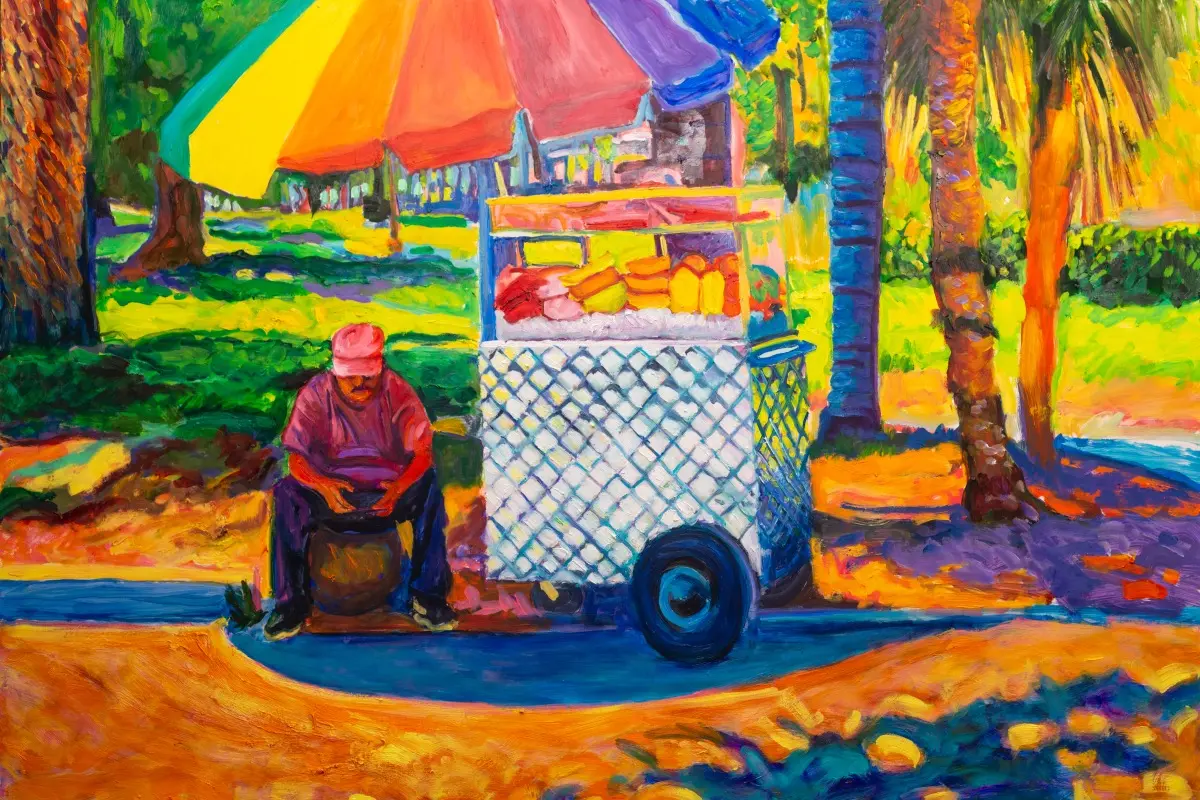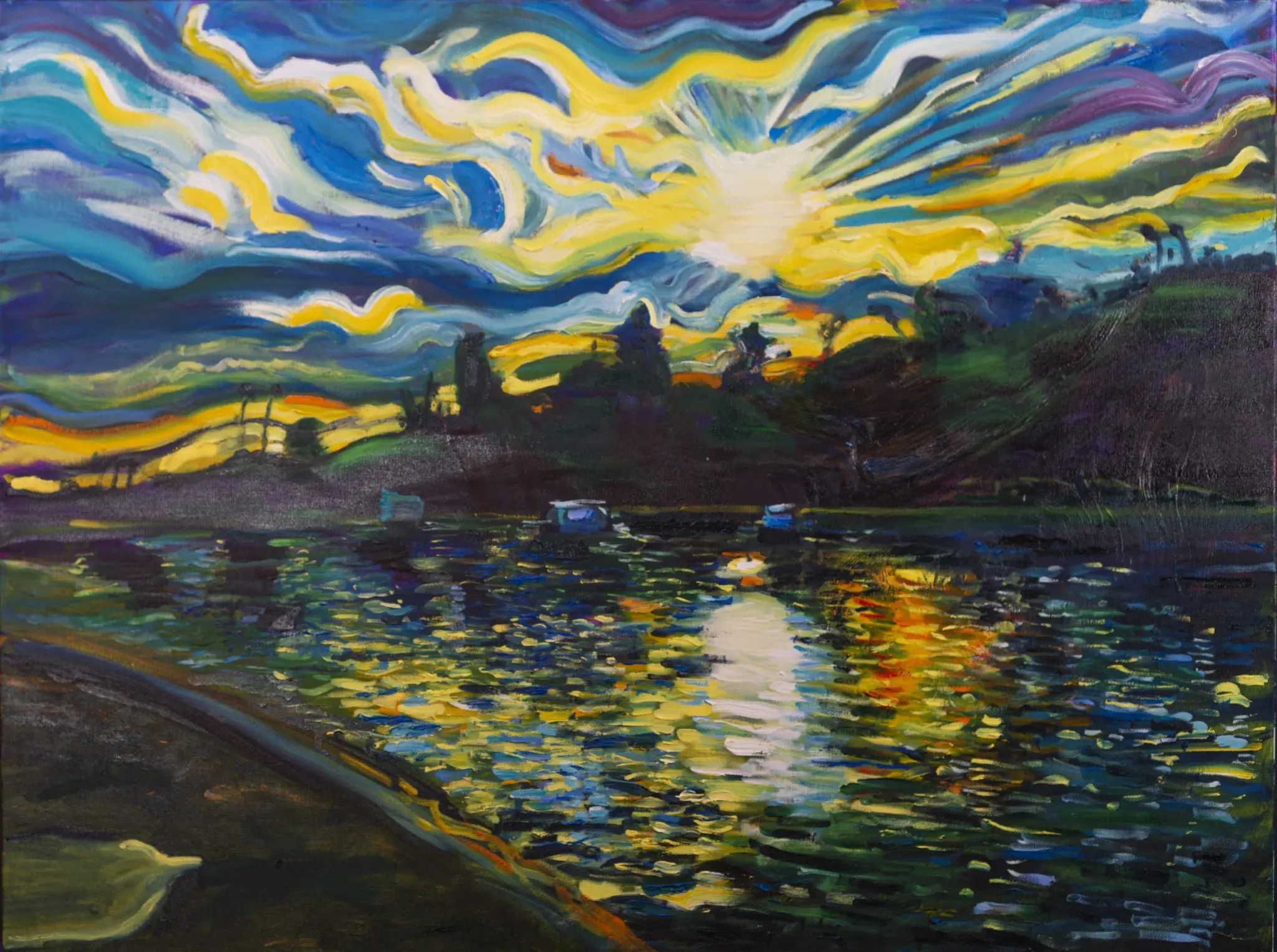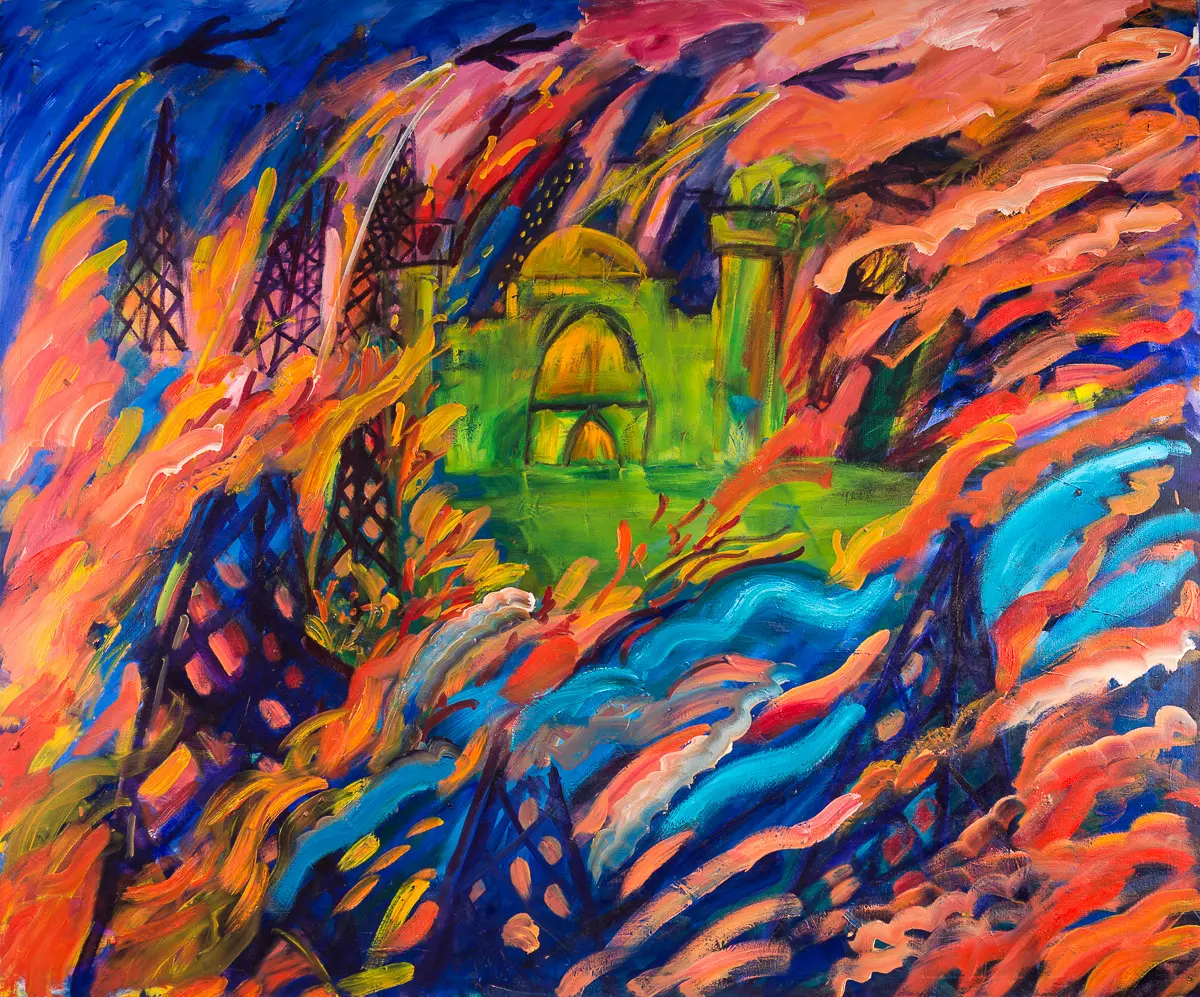

‘American Dream’ (2020, oil on canvas) by Margaret Garcia (Courtesy of Martha Benedict)
VENTURA, California — Arte Para La Gente (Art for the People) is Chicana artist Margaret Gracia’s first retrospective exhibition. For Garcia, at 70 years of age, the exhibition is a lifelong dream come true.
Running from November 22, 2021 to May 22, 2022 and curated by Anna Bermudez, the selection of artwork on display at the Museum of Ventura County in California spans 37 years, beginning in 1985, and represents a milestone in Garcia’s career as a dedicated community artist. Actor Cheech Marin holds one of the largest collections of Garcia’s work.
In this collection, Garcia draws from her immediate surroundings for inspiration. Her portraits are of close friends with whom she has developed strong bonds. Garcia’s landscapes act as cartographies charting dear memories of her community and the places she has experienced.
She paints immediate moments engraved in her memory and immortalized on canvas. Without a doubt, Garcia is the Van Gogh of our times, giving color to scenes that would otherwise be pale and present a monotonous and gloomy expression.
Garcia is known for her bright color palette and her course textured style of painting. The colors she uses are close to those used by many Latin American artisans, especially Mexican. Of Mexican heritage, Garcia spins the use of color on beautiful artisan craftwork onto her expressive colorful canvases.
For scholar Karen Mary Davalos, professor of Chicano and Latino studies at the University of Minnesota, Twin Cities, “Margaret Garcia has developed her own color theory … Her color theory requires an understanding of high key color radiant and how the luminous and lustrous qualities work together.”
With bright pulsing colors, Garcia searches for equilibrium between the banal, the invisible, and the privilege to experience life but once in a lifetime. Her painting process presents many moments of meditation between the canvas, her color palette, her painted subject, her soul, mind, and heart.
In her painting, American Dream (2020, oil on canvas), Garcia captures a silent moment on a bright day of a paletero (popsicle vendor) sitting on the curb of a park walkway. He is alone with no customers to attend to, surrounded by a lush scene featuring Southern California’s iconic palm trees and lime green foliage.
Paleteros and other street vendors (including taco stands) are commonly stationed at parks, on local community streets, and throughout most of Los Angeles, particularly in Latino neighborhoods. Many of the street vendors are immigrant men and women who came to the United State in pursuit of better economic opportunities. The search comes with many risks. Paleteros and other street vendors such as eloteros (corn sellers) have been victims of assault, violence, and discrimination. As street workers trying to eek out a living, they face multiple challenges.
Garcia, like Van Gogh, has a common concern—for Van Gogh it is the peasant farmers, for Garcia it is the common worker and the common person. Both manifest in their paintings a gaze of dignity, empathy, and acknowledgment for those who toil day in and day out and who, for the most part, are hierarchically categorized at the low end in modern capitalist societies, where prestige is to be found at the top and hardly ever at the bottom.


‘Glorious Echo Park’ (2020, oil on canvas) by Margaret Garcia (Courtesy of Martha Benedict)
In Glorious Echo Park (2020, oil on canvas), in the midst of a world pandemic, Garcia sets her painting of Echo Park Lake against the background of smooth hills with trees. The majestic sun mirrors its glory against waves strolling along the tranquil lake’s mirror-like surface. Slightly above the hills, the sun streams its rays outward as a warm gesture of gentleness.
Echo Park Lake is a landscape sought out by many artists. The lake was one of Chicano artist Carlos Almaraz’s favorite sites to paint. Almaraz captures in many of his fabulous Echo Park night scenes the silhouettes of downtown Los Angeles and the mystery and nightlife with sharp diagonal strokes of paint.
Garcia, on the other hand, chooses an angle that avoids downtown, the political powerhouse of L.A., snuffing it out entirely. She bypasses any reference to power in the far distance, unlike Almaraz. Instead, Garcia paints a promising horizon: warm, generous, and hopeful during difficult times full of uncertainty. The sunlight spans across the skyline with comforting blues and yellow hues. It is tender and kind. Her strokes are soft, curvy, long, playful, and jazzy. They resemble the mane of a lion tossed by wind. Garcia, like her Indigenous ancestors, pays homage to life with this painting. Echoes of the sundance stomping the ground can be heard from far away.
In this particular piece, Garcia proclaims her respect for the sun as an essential living element, not just for life but for inspiration and hope. Garcia does not edge herself away from nature as a separate entity, but unifies earth and humanity in a holistic circular perspective of mutual coexistence, as an anti-Cartesian argument against the separation between mind and body. Glorious Echo Park is Garcia’s love prayer for all of humanity.
Garcia’s landscapes deserve special attention. With a diverse mix of highlights and radiance, they are also reminders of the gradual disappearance of extraordinary natural beauty. With the slow grind of modernization against the environment, inspirational landscapes fade into memory, like Iztaccíhuatl, Mexico’s third-tallest volcano, which has lost its signature snowcap. Iztaccíhuatl’s mystic energy has been a fountain of inspiration for filmmakers, photographers, artists (like Mexican painter Dr. Atl), poets, writers, and especially for Chican@ muralists as an extension of self-determination. The glacier that once crowned Iztaccíhuatl has been declared extinct due to global warming.
Most of Garcia’s work is inspired by what she feels more so than what she thinks. She responds to the world with heart and soul. Her platform of motivation is la gente (the people).
In Shock and Awe (2005, oil on canvas) — the strongest political protest painting in the exhibition— Garcia addresses the destruction of life by the U.S. government in the Iraq War. U.S jets fly across the sky, bombing mosques below. Burning oil wells contaminate the horizon and the air.


‘Shock and Awe’ (2005, oil on canvas) by Margaret Garcia (Courtesy of Martha Benedict)
Garcia’s paintings are particular, but Shock and Awe is her most universal work. “It is one of her most dramatic works on canvas,” as I wrote in 2016. “It is a most discomforting tale of war and destruction with so much truth that it is hard to believe such an apocalyptic obliteration could be painted in color.”
Garcia is the only Chicana artist amongst many who points out the contradictions and fallacies behind the U.S invasion of Iraq. Iraq’s oil-rich land was the primary excuse to wage war against the country. Her concern in the painting is the terror experienced by children, families, and the Iraqi people generally during the war. Mosques engulfed in flames capture her anxiety. In Shock and Awe, the horror of war haunts Garcia. It is no coincidence that such horror is painted with bright colors since, for Garcia, we experience the world in color. Shock and Awe is the death of color that translates into the death of life.
The exhibition would not have been complete without the presence of La Virgen del Rio de Porciuncula (2001, oil on canvas). Garcia positions the young virgin leaning against a youthful tree painted in deep royal purple. She looks pregnant and at rest. The virgin’s green tunic displays the Mesoamerican stars resembling yellow fluorescent luciérnagas (fireflies)—they are the same as those in Tonantzin Guadalupe’s tunic. A stream of water (Porciuncula River, known today as the L.A River) in turquoise and green hues patiently flows on by. The trees, the stream, the leaves, the tall grass, the hill behind the virgin, and the succulent flower at the forefront of the canvas all seem to be engaged in the aura of La Virgen del Rio de Porciuncula.
Scholars of the history of Los Angeles understand La Virgen del Rio de Porciuncula as part of the city’s original name: “El Pueblo de Nuestra Senora de Los Angeles di Porcuincula.” The celestial map makes the virgin unique, given that there are no European Virgin Marys with celestial maps gravitating on their mantel.
The image of Tonantzin Guadalupe for many Chican@ artists is dear and spiritual. It is so for Chicano artist Fernando Barragan, whose main protagonist in his wall-sized painting No Somos Animales is Tonantzin Guadalupe. Yet there are some Chican@ artists who critique those who do include virgins in their exhibitions. For those who do, the following can be said:
“The presence of La Virgen de Guadalupe who led during the early 19th century the people’s political resistance during Mexico’s struggle for independence” is essential for understanding Mexico’s history, as I explained in February. “It is the same symbol that the anti-imperialist Indigenous rebels, the Zapatistas hold as a banner along with many other icons close to their cause. Scholar Miguel Leon Portilla in Tonantzin Guadalupe: Pensamiento nahuatl y mensaje cristiano en el Nican mopohua describes this powerful indigenous icon Tonantzin Guadalupe (Tonantzin in Nahuatl language translates to our mother) as the most significant fountain of inspiration and Mexican identity.”
Arte Para La Gente reveals one of the many challenges for Chicano/Latino artists with no Chicano museum in the city of Los Angeles. Why must Chican@s exhibit outside the walls of Los Angeles, in cities like Riverside, in the newly built Cheech Marin Center for Chicano Art and Culture, or art venues like the Ventura County Museum?
Garcia’s particular artwork requires more than a theoretical color theory examination; it requires more than the traditional art liberal critique or studied through the lens of a linear art historical timeline. There are two parallels that run through Garcia’s work: what is visible and what is not. What is present but not visible in her artwork is a philosophical reflection. This reflection is a call to take into consideration the multiple categories/experiences which shape life and how they all intersect at times in harmony and other times in opposition to the will of life. Garcia’s work is a bridge between the past and the present.
Several of Garcia’s quotes are placed along the walls to accompany the artwork. Many ring with poetic resonance. One reads:
“Sometimes I feel like an envelope brown and unaddressed. This is an effort to fill that envelope and address it. It is a personal journey that takes place in my history, my family, my heritage, and my identity. It is a physical identity encompassed by a social identity. I look to become whole so that I may become part of the whole.”
The exhibition is meant to make one feel at home. Comfy couches lounge around for visitors to sit and engage with the paintings from different angles. Garcia’s weathered easel sculpts the space with its presence. The collection is installed with the eye level of children in mind.
Garcia the activist, the environmentalist, the mentor, the artist and friend leads the way for Chicano representation. She’s been consistent for the past four decades, giving voice to the people. Her personal narrative, as well as her community work, is essential to understanding the history of Chicano art in the city of Los Angeles. Garcia does not choose what she is going to paint. Life chooses her to paint life.
When asked how she represents her community, Garcia responds: “By painting my community!”
***
Jimmy Centeno holds an associate’s degree in liberal arts from East L.A. Community College, a bachelor’s degree in Latin American studies from Cal State Los Angeles and is concluding a second master’s in art history.


